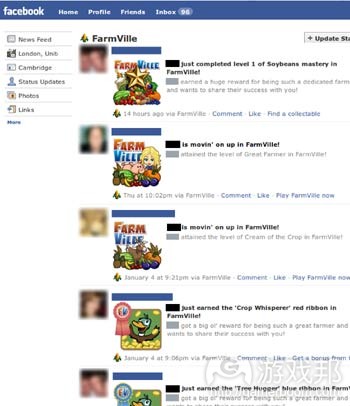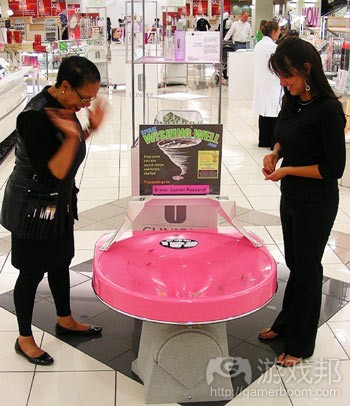论述影响用户行为的11种游戏设计模式
游戏非常擅于让用户长久沉浸其中,更直白的说法是,通过设计影响用户行为。下面是我总结的11种影响用户行为的模式,它们源自游戏或其他趣味形式。
如果你给用户创造挑战,或是基于他们操作的内容设定目标会出现什么情况?
懂得将咖啡盒设成投币目标点的人一定非常清楚如何令大家捐款,并且乐在其中。
如果你出乎意料地给予玩家奖励,令玩家持续体验会出现什么情况?
类似此硬币助推器的电玩游戏通常通过融入强烈的无法预知元素促使玩家持续体验/付费。
你能否就用户操作给予积分或评级之类的反馈,让他们拥有参考标准?
Dr Kawashima系列任天堂游戏中的“脑年龄”积分就能有效促使用户持续访问应用。
你能否将机制分解成能够进行比较的等级,让用户觉得他们始终处于进步中?
容易达到的等级能够降低参与门槛,让游戏拥有持久粘性(游戏邦注:例如《FarmVille》的做法)。
能否在机制设计中通过奖励鼓励用户实施或继续某行为?
Kai’s Power Tools就设置了“奖励功能”,旨在奖励那些能力得到提升的用户。
能否设计某些旨在同用户“嬉戏”的内容,激发他们的好奇心或进行游戏互动的欲望?
许愿池将慈善捐款变成有趣活动,激发过路行人的好奇心。
能否通过设计讲述故事,激发用户的兴趣,让他们融入其中?
戴森电器通过叙述手册将用户带入公司和技术背后的故事。
能否刻意留有间隙(游戏邦注:在设计和信息中),令用户填充信息,沉浸于过程中?
维基百科上的红色链接代表文章“鼓励用户补充更多信息”。
如果你的机制给用户设定特定角色,或让他们觉得自己是在扮演某角色会出现什么情况?
如果你创造设计机制鼓励用户收集系列事物(朋友、活动、地点和物件等)会出现什么情况?
UbiFit Garden鼓励用户定期进行各种锻炼,以“收集”各种花朵。
若你试图让自己的设计变成用户愿意传播的内容,且简化其中操作,会出现什么情况?
ShareThis及类似快速访问的社交分享服务能够令有趣故事快速“传播”。
游戏邦注:原文发布于2010年3月22日,文章叙述以当时为背景。(本文为游戏邦/gamerboom.com编译,拒绝任何不保留版权的转载,如需转载请联系:游戏邦)
Learning from game design: 11 gambits for influencing user behaviour
Games are great at engaging people for long periods of time, getting them involved, and, if we put it bluntly, influencing people’s behaviour through their very design. Something conspicuously missing from Design with Intent v.0.9 is a satisfactory treatment of the kinds of techniques for influencing user behaviour that can be derived from games and other ‘playful’ interactions. I hope to remedy this in DwI 1.0, so here’s a preview of the eleven patterns I’ve included in the new Ludic Lens on behaviour change: patterns drawn from games or modelled on more playful forms of influencing behaviour.
These aren’t original, by any means. People such as Amy Jo Kim (see her great presentation ‘Putting the fun in functional’), Sebastian Deterding, Francisco Inchauste, Jeremy Keith, Geke Ludden, and of course Ian Bogost have done work which explores this area from lots of different angles, and it also draws on decades of research in social psychology. Russell Davies’ Playful (which I really should have gone to!) looks like it was very pertinent here too. (Note, this lens doesn’t cover Game Theory-like patterns, some of which are indeed relevant to influencing user behaviour, but which I’ve chosen to group under a new ‘Machiavellian Lens’)
My main interest here is to extract the design techniques as very simple design patterns or ‘gambits’that can be applied in other design situations outside games themselves, where designers would like to influence user behaviour (along with the other Design with Intent techniques). So these are (at least at present) presented simply as provocations: a “What if…?” question plus an example. The intention is that the card deck version will simply have what you see here, while the online version will have much more detail, references, links and reader/user-contributed examples and comments.
What happens if you set people a challenge, or give them a target to reach through what they’re doing?
Whoever laid out this coffee tub as a target for throwing coins knew a lot about influencing people to donate generously and enjoy it.
What happens if you give rewards or feedback on an unpredictable schedule, so users keep playing or interacting?
Arcade games such as this coin pusher usually employ a strong element of unpredictable reinforcement, to keep users playing/paying
Can you give users feedback on their actions as a score or rating allowing comparison to a reference point?
The ‘Brain Age’ score given by Dr Kawashima’s games for Nintendo gives users a clear incentive to keep using the software.
Can you split your system up into achievable levels which help users feel like they’re making progress?
Easy-to-reach levels lower the barriers to participation and encourage continued engagement for games such as FarmVille.
Can you encourage users to take up or continue a behaviour by rewarding it, through the design of the system?
Kai’s Power Tools (pioneering visual effects software) revealed ‘bonus functions’ to reward users who developed their skill level.
Can you design something which ‘plays’ with its users, provoking curiosity or making interactions into a game?
Spiral wishing wells turn giving money to charity into something actively fun for donors, and provoke curiosity of passers-by.
Can you tell a story via your design, which interests users and keeps them engaged?
Dyson uses narrative booklets drawing customers (and potential customers) into the story behind the company and its technology.
Can you leave deliberate gaps (in a design, message, etc) which users will want to fill, becoming engaged in the process?
Deliberate use of red links on Wikipedia, signifying articles which should be written, “encourage[s] new contributors in useful directions”
What happens if your system gives users particular roles to play, or makes them feel like they’re playing a role?
Tim Holley’s Tio encourages children to become ‘energy champions’ for their household, influencing parental behaviour.
What happens if you encourage users to collect a set of things (friends, activities, places, objects, etc) through using your system?
UbiFit Garden encourages users to maintain a regular variety of exercise activities, in order to ‘collect’ different types of flower.
What happens if you plan your design to be something people want to spread, and make it easy for them to do so?
ShareThis and similar quick-access social sharing services can mean rapid ‘viral’ or ‘meme’ status for interesting or amusing stories.
The text and examples aren’t quite fixed yet, so any comments and feedback on the above are very welcome.
Spiral wishing well photograph courtesy of Steve Divnick – see this video if you don’t believe the power of the well; UbiFit Garden images from DUB at University of Washington; ShareThis Chicken Poncho screenshot from this listing on Regretsy; Tio image from Tim Holley.(Source:architectures)
下一篇:情感影响力或可成为游戏新衡量指标


















































 闽公网安备35020302001549号
闽公网安备35020302001549号